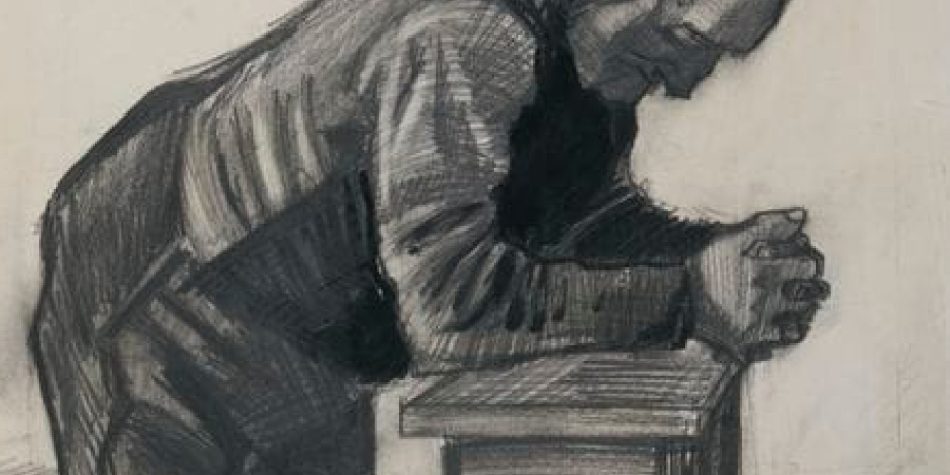Ernest Hemingway is one of the more enigmatic historical figures. He loved a great fight and a great cigar.
But what would he be like after he dies?
Scott Hales’ new book “Hemingway in Paradise” is a collection of poems about historical figures and what their lives now look like in the Latter-day Saint conception of the Spirit World.
In Hales’ take, Hemingway tries to change and gives it his best go—he even attends Elders Quorum. But ultimately, Hemingway is drawn in by the romance of his vices and his love of the flawed.
Change isn’t easy—and is sometimes downright hard. And it is this reality that motivates much of Hales’ latest book. “Progress, not stasis,” he writes in a poem about Dale Carnegie, “was the object and design of existence in heaven.”
Change is also at the heart of most of our cultural conversation. The self-help boon of the nineties has started to fade. In its place, a therapeutic worldview has become explicit and nearly universal. “I was relieved. It was wonderful to think that everything I did that my parents didn’t like was actually their fault.”
This worldview and its associated language of disorder, self-esteem, trauma, addiction, validation, vulnerability, and the like have been ascendant in the United States over the last sixty years. And with this psychological worldview firmly in place, this generation has seen a destigmatization of all things therapeutic—reflected and resulting in people attending therapy more often, discussing it with others, and even seeing heroes appreciating it in our pop culture.
The sociologist Eva Illouz observed that a “therapeutic ethos” can now be found across national and regional differences. She says that no other worldview has had as much of an influence on the way we view the individual today (other than, perhaps, political and market liberalism).
I Am Who I Am
Not all of the characters in Scott Hales’ conception of the afterlife are doing their best to change. “The King,” a poem about the Marvel comic artist and writer Jack Kirby, tells a story about a man who may be intrigued by growth but ultimately has a self-assured identity. “He is not keen on changing” because he feels “content.”
But the how of Kirby’s feelings is much less interesting than the why.
As Hales sets to creating a character uninterested in change, he relies on identity and circumstance. Kirby does not want to change in this telling because “he’s a Jewish kid from NYC” and served in wars both literal and literary. If that’s who he is, why would he ever need to be anything else?
Kirby’s position is at home within the therapeutic ethos. One of the key “simplifying assumptions” in social science research is “determinism”—the theory that what we do is the result of our circumstances and that we don’t truly have free choice. Many have long assumed that without invoking determinism in one way or another, social scientific research would be impossible, despite many having convincingly argued this is not the case. As a result, the research and discourse mental health clinicians are educated in are steeped in this assumption. It’s natural to wonder how much of this assumption gets carried into the therapy room.
As part of my research for my upcoming book on the intersection of faith and mental health, I sat down with Bonnie (name changed). Bonnie’s family has deep ties in a mainline protestant denomination, though her beliefs have started to shift more toward evangelicalism.
Bonnie had four children in their teens and early twenties. Three of them still live at home. And she described to me starting to observe them make choices that frustrated her. Her youngest, a freshman in high school, had recently been caught drunk—while her college-aged son had just failed several classes.
Bonnie admitted that her temper had begun to rage. She would shout and guilt her kids. At one point, she even broke a plate. And while she felt bad for doing that, she couldn’t help but feel even worse about the lower-level temper she had when her children were younger.
If her temper hadn’t been quite so quick when her children were younger, would she be dealing with the same difficulties today?
These questions began to cause her some deal of anxiety and depression, so she visited a Christian therapist.
There is, of course, no way to know what Bonnie’s therapist told her exactly, but when she spoke to me, she described the process as one of discovery. “I used to think that I was the one hurting my children,” she said—“That it was my fault. But I didn’t realize that it was because my dad had abused me. My friends were never there for me. And my husband was too busy with other things.”
She paused to clarify, “My husband is a good man, but when it’s come to parenting, he’s always left me on a limb.” Bonnie recounted how session after session, she discovered more of the presumed causes of her behavior.
“I thought I was sinning,” she told me over a zoom call, quilts hanging on her wall in the background, but in her estimation, “that was only because I didn’t have enough faith.”
I asked her to tell me more, and she began to get choked up, her already rosy cheeks spilling over. “Jesus overcame sin. He did it. He did it all. It’s not my sin. It’s the circumstances of the world. And Jesus overcame the world. I literally can’t sin.”
Just like Hales’ fictional Jack Kirby, Bonnie had arrived at the point where personal change was no longer so relevant or crucial because, after all, her own behavior was largely arising from her unchosen identity and circumstances.
My own interest in the topic was first piqued by failings of my own—including times when I lost my own temper at home. And when I sought out other advice about these issues, both my own therapist and therapeutically aligned online communities focused on the circumstances that precipitated my failings. Instead of considering my own actions, I found it all too easy to get caught up in focusing on actions and choices my former spouse was making. I was able to console myself that my responses were warranted by her behavior. And thus, through this rationalization, I could place the fault for my own behavior outside of myself.
My therapeutically-minded support network, including professionals and friends, was all too happy to apply clinical language to my circumstances—positioning me as a victim of painful circumstance that explained everything I was feeling and doing.
This narrative seduced me. Blame shifting brought definite relief to my psychic pain, especially with the authoritative imprimatur of the therapeutic community.
Trauma Made Me Do It
At one point, Scott Hales turns his attention to Christopher Columbus’ after-life fate. In this retelling, Columbus has been condemned to spirit prison and is rather upset about it. He spends most of the poem rationalizing. He had been inspired by God. His travels aided in the spread of Christianity. Nobody he knew would have done anything differently. At one point, he goes so far as to ask himself, “What were rape, slavery, conquest, and genocide when … life in this round world was cheaper than accountability?”
But all of Columbus’ rationalizing not only failed to save him from spirit prison but prevented him from finding peace, “why was he still tormented, racked with the anguish of the damned?” As a result of Columbus rationalizing his past, he demonstrates no change or forward momentum. He doesn’t even consider it.
Rationalizing our pasts can have the effect of preventing us from changing, or using the religious vernacular, “repenting.”
I asked Bonnie if she still yelled at her kids, “Of course,” she said, “but only like everyone else.”
One common tool that contemporary therapists use to help understand their clients’ behavior is looking at someone’s past and examining potential trauma. The assent of such careful attention to trauma began in trying to explain the response of soldiers who fought in the Vietnam War. In so many instances, such awareness of the past has undoubtedly benefited someone’s healing process.
But over the last twenty years, there has been a push in psychology to expand and dilute this definition. Today more than 80% of therapy clients are said to have experienced trauma. The sociologist Frank Furedi has written that “today, trauma means little more than people’s response to an unpleasant situation.” The trend has resulted in a popular meme of the fictional next volume of therapists’ diagnostic tool subtitled “Oops all Trauma.”
In the deterministic model, this kind of trauma—especially its diluted definition—acts as the causal circumstance that clients can use to justify present behavior. In doing so, they are applying this therapeutic ethos that more deeply understanding our psychological mechanisms is enough to be liberated from them. This can create a legion of Columbuses complaining that they only did what anyone else would have done in their circumstance.
Validation No Matter What
To Latter-day Saints and many other people of faith, this rationalization butts up against the conception of sin or that certain behaviors are wrong regardless of the circumstances.
The therapeutic worldview not only provides the ballast for this kind of circumstantial rationalization but validates the rationalization as well. Validation is a key component of contemporary therapy—wherein clinicians not only understand their clients’ behaviors and feelings but recognize them as “valid.”
When clients present rationalizations to their therapists, who are then professionally compelled to validate them, we end up with a situation where people may feel supremely justified in their rationalizations—thanks to this authoritative stamp of approval. To resolve client issues, therapists are then left with two paths. First, they can help the person remove any doubts about their rationalizations—making them less psychologically distressed since they’d be more confident in their own lack of guilt. Second, they can help their client address the circumstances which are producing this behavior. “None of the work figuring out why I did the things changed that I did them. The only thing that worked was realizing that I was the one doing them, so I would have to be the one to stop them.”
So Diane’s therapist also helped her along the second path—coming to be trained in a process where she was more assertive in telling her husband how she wanted him to act. That kind of confrontation may eventually result in some of her behavior changing as well, but only as part of changing the circumstances that created it.
Not all theorists have moved entirely away from an accountability model. C. Terry Warner and James L. Ferrell, for example, have written extensively on the subject. But notably, their work often gets adopted in business and religious studies more often than therapeutic ones. And these trends hold up when looking at the therapeutic field as a whole.
Rediscovering the Whole Soul
Perhaps the apex of Hales’ book comes in an exploration of Joseph Merrick. After death, his circumstances dramatically change now that he no longer has the body that caused so many to mock him as the “elephant man.”
But when he meets Michael Jackson at the grocery store, we learn how long he had resented him (the late pop star had purchased Merrick’s remains and used them distastefully in a music video).
But Merrick is able to change at this moment, not because his circumstances had changed, but by extending to Jackson the same grace he wished others had extended to him, recognizing that they had both spent mortality behind a mask.
For Latter-day Saints, peace comes from positive change, which change is catalyzed by accountability.
I met Tasha in her home in southern Utah. She smiled and then sighed. “I haven’t talked about counseling in a long, long time.”
She told me a story of totally destroying her life. As a teenager, she hated her parents for enforcing what she saw as backward and needlessly strict rules. So she broke them out of spite. By the time she was twenty, she was struggling. She still lived at home, but her parents were ready to kick her out. And they gave her an ultimatum: meet with the bishop or get out.
She no longer considered herself religious and negotiated a compromise to see a counselor instead. During her first session, Tasha says that she was defiant and dismissive of the process. She enjoyed her vices and saw the professional meeting as something of a con to keep her parents supporting her as long as possible.
It was after only a few sessions that Tasha says she discovered how much her counselor enjoyed her complaining about her parents. She told me that while her counselor never said she liked it, she always perked up, asked more questions, and ended by saying they had done good work.
“In some ways, you could even say it worked. I was relieved. It was wonderful to think that everything I did that my parents didn’t like was actually their fault. It didn’t change anything I did, but my parents stopped asking me about it as much because every time they did, I just told them how it was really all their fault.”
After going to therapy for a little over a year, Tasha’s behavior hadn’t changed. And while drunk driving, she hit a light pole. She tells me that, in retrospect, it wasn’t all that serious. She only spent a week in the hospital. But at the time, it changed everything. “None of the work figuring out why I did the things changed that I did them. The only thing that worked was realizing that I was the one doing them, so I would have to be the one to stop them.”
Tasha told me that she tried to tell her therapist about her change of heart. But her therapist was hesitant and discouraged her from trying to do too much too fast. So she quit therapy. By the end of that year, she was sober and going to school.
My experience in counseling was similar. None of the work interrogating and blaming my circumstances brought me peace. But simply recognizing that I was the one who made my choices and taking proactive steps of repentance to make different ones changed how I felt substantially.
Repentance brings peace because we can be totally honest with ourselves, not worry about indicting anyone else, and can still move on forgiven.
It is not always easy. The most heart-wrenching poem in Hales’ book comes in an exploration of the afterlife of Nathan Bedford Forrest. Forrest was a Confederate army general in the American Civil War and the first Grand Wizard of the Ku Klux Klan.
He is also in spirit prison. At first, he lies about his past, thinking that there was no point in trying to improve because had always believed that people didn’t change. But he discovers that “heaven was all about changing.” And so he does. At first, he finds other things to do with his curtains and bed sheets, then he begins to volunteer, to listen, and to open up about “the terrors he inflicted.” Forrest spends “centuries trying to make amends” but still feels like he’s wearing cement slippers at the poem’s end.
Yet in Hales’ telling, there remains more hope for Forrest than for other characters who refuse to improve. Yes, he may still be in the middle of complete sorrow at the poem’s end, but it’s only because in learning to listen, he’s developed a conscience, and it’s that forward momentum that gives the poem its unexpected hope.
We may be losing that hope as a therapeutic circumstance explanation for sin replaces a model of accountability and repentance. None of that, once again, is to suggest that there aren’t tragic adverse circumstances that deserve the “trauma” label—or the fact that real burdens sometimes do indeed predispose certain people to negative behaviors.
But all too often, we continue to see situations where those who seek out therapeutic help leave feeling that their circumstances create emotions that can’t be changed and are, therefore, necessarily valid—reflecting behaviors that are contextually determined. And this therapy ends up helping clients feel increasingly justified in their choices and more powerless to make positive changes. And it’s this recipe that, left unchecked, could ultimately prevent so many suffering souls from finding the peace that can only be found through repentance.
















